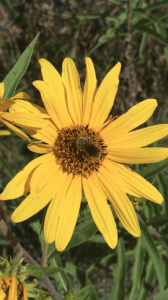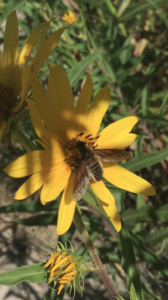 During a hike on the greenbelt this weekend, I saw some pretty yellow flowers that I thought would be great for the biodiversity post this week. Then, I saw bees surrounding the flowers so naturally I tried to get photos of them instead. Of course it wasn’t pleasant standing in the middle of a swarm of bees but I did it for the blog! After spending most of this morning looking at bee identification websites, I have come to the conclusion that these were honeybees (could be wrong), scientifically known as Apis mellifera.
During a hike on the greenbelt this weekend, I saw some pretty yellow flowers that I thought would be great for the biodiversity post this week. Then, I saw bees surrounding the flowers so naturally I tried to get photos of them instead. Of course it wasn’t pleasant standing in the middle of a swarm of bees but I did it for the blog! After spending most of this morning looking at bee identification websites, I have come to the conclusion that these were honeybees (could be wrong), scientifically known as Apis mellifera.
 Honeybees are generally divided into three types: workers, the queen, and male bees which are called drones. Workers are the only bees most people ever see. Like ants, they are females that are not sexually developed. They have many jobs which include foraging for food, such as nectar and pollen from flowers as seen in the photo, building and protecting the hive, cleaning, circulating the air by beating their wings, and many other social functions. The queen’s only job is to have babies, but she also regulates the activities of the hive by producing chemical to guide behavior. There is only one queen per hive, and when she dies, a worker female in the colony is fed a special elixir which allows her to be a fertile queen. Males, or drones, live in the hive during the spring and summer but are expelled during winter months while the hive goes into lean survival mode. During this time, the hive lives on stored honey and pollen and cluster into a ball to conserve warmth. Honeybee hives have been providing humans with honey and beeswax for many years, spawning a large beekeeping industry, but many still exist in the wild.
Honeybees are generally divided into three types: workers, the queen, and male bees which are called drones. Workers are the only bees most people ever see. Like ants, they are females that are not sexually developed. They have many jobs which include foraging for food, such as nectar and pollen from flowers as seen in the photo, building and protecting the hive, cleaning, circulating the air by beating their wings, and many other social functions. The queen’s only job is to have babies, but she also regulates the activities of the hive by producing chemical to guide behavior. There is only one queen per hive, and when she dies, a worker female in the colony is fed a special elixir which allows her to be a fertile queen. Males, or drones, live in the hive during the spring and summer but are expelled during winter months while the hive goes into lean survival mode. During this time, the hive lives on stored honey and pollen and cluster into a ball to conserve warmth. Honeybee hives have been providing humans with honey and beeswax for many years, spawning a large beekeeping industry, but many still exist in the wild.
You can find my iNaturalist post here.
References
http://animals.nationalgeographic.com/animals/bugs/honeybee/